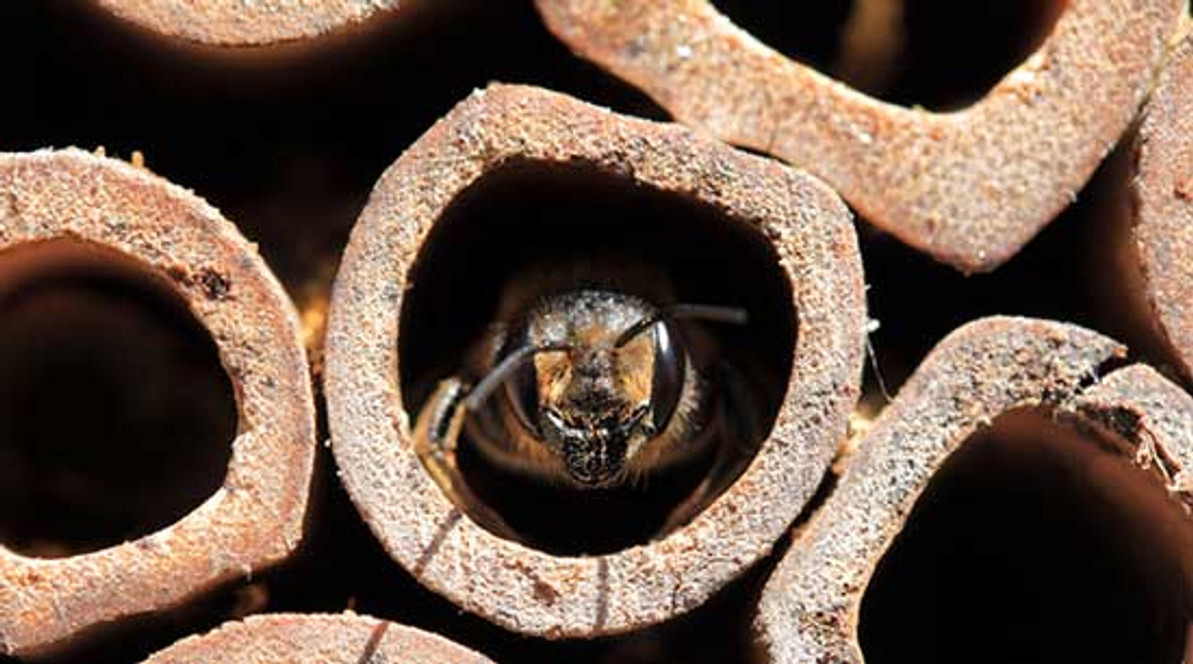Why You Should Raise Native Bees and How To Do it Successfully
Raising native bees creates diversity in your ecosystem, which helps to ensure that all different types of plants are being pollinated. About 90% of native bee species are solitary, meaning they do not live in colonies or produce honey, making them easy to raise. Every female solitary bee lays eggs and takes care of her young on her own, which makes them very gentle and unlikely to sting, as they are not defending a hive or honey.The manner in which native bees, like the mason bee, forage and carry pollen makes them very efficient pollinators. They carry pollen loose in the hairs on their bellies, which allows more to fall off in each flower they visit. They are not as meticulous as honey bees, meandering from flower to flower on different plants, which allows for efficient cross-pollination. Probably one of the biggest advantages of raising native bees, especially if you have an apple orchard or other early-blooming crops, is that native bees like the mason bee will fly and forage in weather much more inclement than our honey bees. They will tolerate temperatures about 10 degrees cooler, and will even fly in wind and light rain.
People frequently ask, will native bees compete with my honey bees? The short answer is, absolutely not! Studies have shown that when farmers increase the diversity of forage near their farms, it has a ripple effect that increases the populations of honey bees AND native pollinators in their area, which in turn increases fruit production. Because of differences in feeding behavior, honey and native bees can live and pollinate side-by-side.
How to raise Native Bees:
Step 1: Install your house
- Select a location that receives early morning sun and provides protection from wind and rain.
- Place the house at eye-level so you can watch them!
- If you decide to paint your house, allow plenty of time for the paint to cure, as the smell may deter the bees.
- If you have a problem with birds – you may need to use wire mesh or chicken wire to protect your bees.
Step 2: Place nesting holes
- Mason bees prefer nesting holes that measure 8mm in diameter. Leafcutters prefer a nesting hole with a 6mm diameter. A variety of native pollinators like a variety of hole sizes. Try them all and see what moves in!
- As a rule, you should try to have at least 1 nest hole per cocoon. Typically female bees claim 2 nesting holes per season. Sometimes more!
- It can be helpful to put pieces of long grass and twigs in with your nesting tubes in order to provide a sort of “map” to help your female bees find their own nesting hole when they return.
Step 3: Release Cocoons
- When the dandelions are in bloom – or daytime temperatures are around 55 degrees – it is time to place your mason bee cocoons outside so they can emerge on their own. Make sure they’re all released by the beginning of May.
- Keep cocoons out of direct sunlight as you wait for them to emerge. Placing them in the top section of your coppertop house is a great option!
- When daytime temperatures are consistently 75 degree Fahrenheit it’s time to release leafcutter bees. Make sure they’re all released by the beginning of September.
Alt. Step 3: Spray Invitabee on nesting material to attract local pollinators already living in your yard if you have not purchased cocoons. Invitabee can be used even if you have purchased cocoons to help better ensure that the bees will return to the house you have provided.
Step 4: Wait and watch!
Harvesting Cocoons for healthier bees and less pests
Harvesting the cocoons from your native pollinator house is a very important step in raising healthy native bees. By opening your nesting materials and removing cocoons, you're able to clean out the pests and disease that would be left behind for the next generation of bees. Read more about how to harvest your cocoons below.
Harvesting Mason Bee Cocoons:best to harvest in the fall (October-December)
REMOVE THEM
- From natural reeds – gently split the reed in half and use a screwdriver or popsicle stick to remove the cocoons.
- From guard tubes with liners – pull the white tube insert out of the cardboard guard tube, begin tearing the end and it should come unraveled. Use your fingers to gently remove the cocoons from the insert. PRO TIP: if you have a lot of inserts, you can soak them in warm water to loosen the glue before you begin harvesting. Do not soak for longer than 30 minutes.
- From wooden trays – remove rubber bands and cardboard backing. Lift trays one by one to expose the cocoons and remove them gently.
SORT THEM
- Sort cocoons from all other debris like mud walls, pollen loaves, or other pests.
WASH THEM
- 1 tbs. bleach + 1 cup water
- Submerged cocoons and stir for a few minutes. If any cocoons sink, it means they have holes and are not healthy.
- Rinse cocoons in fresh cool water.
- Lay them out to dry.
STORE THEM
- We recommend storing them in the refrigerator set between 34-40F
- They are prone to dehydration – so it is a good idea to store them in some sort of Tupperware container or bag with holes for ventilation and a damp paper towel or sponge to keep them moist, but not wet.
Harvesting Leafcutter Bee Cocoons: best to harvest in late winter or early spring (about 6 weeks before your summer garden begins to bloom)
- Once you notice leafcutter activity has stopped for the year, you may store your tubes or wood trays in a mesh protective storage bag in a cool place until you are ready to harvest.
- Follow the same steps for opening the nesting material as listed above.
- Do not wash leafcutter bee cocoons.
- Separate cocoons from other debris and pests and place back in you mesh protective bag. Store in a cool place like an unheated garage or shed until it is time to release them.
Recent Posts
-
Unleashing the Sweet Potential: A Comprehensive Guide to Honey Marketing
Introduction: In the buzzing world of beekeeping, producing high-quality honey is just the beginnin …May 17th 2024 -
Beekeeper in the Big Apple
Home to the busiest streets in America, cars lined bumper to bumper, herds of young professionals ma …Sep 28th 2022 -
Robbing Honeybees: Detection and Prevention
As a beekeeper, it is important to be able to understand what robbing is and how to recognize …Sep 22nd 2022




